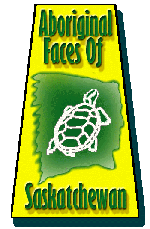|
 |
||||||||
FSIN Citizen of the Year By Harry Lafond and Carol Lafond Reprinted
with permission from
How do you share a special person with an audience? I don't know how but here are my thoughts and feelings about a special person from my community. She was a colleague; she was a friend; she was a mom; she was a community member, and above all, she was a wife. She was Anita. In First Nations communities, there are often jobs or tasks that are undertaken by someone. It is their "duty." For example, some communities have, by years of doing so, certain people who dig their graves for recently departed, others who make the ribbons for the pall bearers, or those who look after the "education" and cultural events. As a community member, you just know who gets the job done. In our community now, there are many situations we are facing where there is void. Brief personal background: Anita was the eldest of five children. Her father, John, was an English teacher and her mother, Florence, was a homemaker to two daughters and three sons. She obtained her grade 12 in Nipawin and her Bachelor of Education at the University of Saskatchewan in 1979. Her major area of study and proficiency was English. More about THAT later. Her first experience as a teacher was at Marcelin School; school for many of the Muskeg students. After two years, she moved on and married Hal Greyeyes. They began their family; Barrett (1983), Adria (1985), and Adam (1989). She continued teaching, while raising her family. She taught at St. Paul, Alberta and Onion Lake. For Anita, when she married Hal, she married his family. His mom was her mom, his sisters were her sisters. Her ties to the reserve were further solidified when she and Hal moved to the reserve in the late 1980's. Anita was employed by the Muskeg Lake Cree Nation as an Education Coordinator. Of course, when you work for a band, your duties are unlimited. With her formal education and past experience with Cree culture providing the basis for her expertise, she began duties about the time Muskeg Lake Cree Nation took control of the K-12 education. With that, came the responsibility of representing Muskeg at the Saskatoon Tribal Council Education Advisory Board. In those early days, policies and guidelines had to be worked on. Funding had to be solicited and secured for support staff, new initiatives and approaches, new curriculum. Anita's strength was her background in English. She was able to prepare proposals for funding and offer insight into modification of curricula to best serve the needs of students and community. She was instrumental in the development of Cree Camp, as it became to be known. She believed in the need for Muskeg Lake to recover its Cree culture and language. With passion and consistency she worked to bring control of education into the community where she promoted language instruction and Cree content curricula to give the students in kihiw School a pride in their history and heritage. With Saskatoon Tribal Council she brought to bear her enthusiasm in writing projects that provided teachers with materials to use in the classroom. At all times, she consciously understood the need to work with people and projects like "The Foundation for Cree Culture" gave her the opportunity to bring that quality to the people of Saskatchewan. Anita was always quick to recognize the elements of strength needed to broaden and challenge the parameters of education. Her work and support of projects such as Super Saturdays, First Nation Giftedness, Celebrating Our Survival Festival and most recently, the trip to Hawaii by the Muskeg Lake Dance Troupe illustrated her understanding that the status quo of education needs to be questioned and challenged by the First Nations. One project that illustrates her commitment to work with children and their parents at the level of their needs is the Group Program at kihiw School. From 1994 to the time of her passing, she spent many hours organizing and recording the results of this program that brings parents into the school to teach their own children in areas that are not covered explicitly by the current curricula. As I explained earlier, you do many things at a band office and First Nation community. In 1992, the post school program began an annual awards dinner. The amount of work to mount such a project was overwhelming. Working with Anita on the many awards banquets and projects was a delight. Anita had many aspects to her personality that allowed for good-natured ribbing. She never hurried; but always got the job done. But she was also a great believer in putting things off. Why do things today if you could get it done tomorrow? I am the same way; so you could imagine the late nights we had putting together the written projects ready for the printer!! But she never had a harsh word for anyone, no matter how someone chose to throw a temper tantrum. As I said before, she never hurried. When she told a story, it was often in flowery language, for lack of a better phrase. She did not embellish (she would have loved that word) but instead embroidered her stories with inconsequential tidbits and hand and facial gestures. I especially remember the story she told me on why she was late to work one day (she also had no concept of time). It seems her husband, Hal, was away to work and left her in charge of the farm. She sent her oldest son out to feed the horses. While she was getting the younger kids ready for school, Barrett rushed into the house to announce that the horse had fallen into the lagoon! From then on, she itemized the trouble she had in getting that horse out of the lagoon, from calling neighbours, friends and a tow truck. She did eventually get that horse out safely. Of a more personal nature, insight about who Anita was is exemplified by the way she lived life. She and Hal often had exchange students, from foreign countries, stay over the summer, or various nieces, nephews or children who needed a place to stay. She was kept busy bringing youngsters, her own and others, to hockey and soccer games. She had a houseful in the summer around the time of swimming lessons. It was her duty to haul various kids, hers and whoever happened to be staying at her house, to their lessons; at the same time she took that opportunity to read a "trashy" novel and catch up on the latest news in the community. She opened up her home to everyone. A cup of coffee was always ready for you, along with whatever she had baked that day. She was an accomplished cook who could be counted on to bring a little something to the various functions held in the surrounding communites. She could be counted upon to introduce "different" foods to us. She earned renown for her broccoli salad, stuffed mushrooms, hot and spicy hamburgers and hotter and spicier chili. She got ladies of the community together to have a "Ladies Night," unknowingly promoting friendship and an exchange and sharing of ideas and good old fun. It did not matter to Anita from what background or community you hailed; she would welcome you. In the summer of 1998, Anita was diagnosed with breast cancer. In the months that followed, Anita continued to work at her many projects with determination and courage. She refused to give up and maintained her contributions until May, 1999 when she was unable to walk on her own. Even from her chair at home, she continued to work with the teachers, colleagues to make sure the school year ended successfully and the children from the Dance Troupe went to Hawaii. I remember seeing her in Hawaii working on Adam's regalia despite the pain of her cancer. Her courage and determination is a memory we hold dear in Muskeg Lake, especially those of us who worked closely with Anita. Anita passed away October 9, 1999. We miss her very much. |
|||||||||








